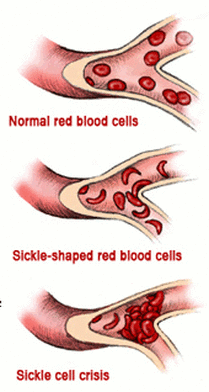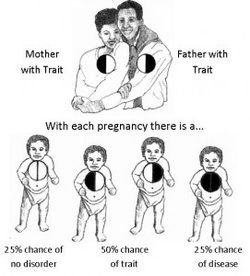Frequently Asked Questions

What is Sickle Cell Disease?
Sickle cell disease is an inherited blood disorder that affects the red blood cells. People with sickle cell disease have red blood cells that contain mostly sickle hemoglobin (S), instead of normal hemoglobin (A). (Hemoglobin is the substance in red blood cells that carries oxygen throughout the body.) Sometimes, in a person with sickle cell disease (SS) the red blood cells sickle (become crescent shaped) and have difficulty passing through small blood vessels. When sickle cells block small blood vessels, less blood can reach that part of the body. Tissue that does not receive normal blood flow eventually becomes damaged. This is what causes the complications of sickle cell disease.
What is the Sickle Cell Trait?
Sickle cell trait is the benign carrier state of sickle cell disease. Individuals with trait do not have any symptoms of the disease, but they can have children with the trait or disease.
What is the difference between sickle cell disease and trait?
People with sickle cell trait (AS) inherit one gene for normal hemoglobin (A) and one gene for sickle hemoglobin (S) from their parents. Because they have one (A) gene, individuals with trait do not have any medical problems, but they can pass the (S) gene to their children. People with sickle cell disease (SS) inherit two genes for sickle hemoglobin (S) from their parents. They have symptoms because their red blood cells do not make normal hemoglobin.
Sickle cell disease is an inherited blood disorder that affects the red blood cells. People with sickle cell disease have red blood cells that contain mostly sickle hemoglobin (S), instead of normal hemoglobin (A). (Hemoglobin is the substance in red blood cells that carries oxygen throughout the body.) Sometimes, in a person with sickle cell disease (SS) the red blood cells sickle (become crescent shaped) and have difficulty passing through small blood vessels. When sickle cells block small blood vessels, less blood can reach that part of the body. Tissue that does not receive normal blood flow eventually becomes damaged. This is what causes the complications of sickle cell disease.
What is the Sickle Cell Trait?
Sickle cell trait is the benign carrier state of sickle cell disease. Individuals with trait do not have any symptoms of the disease, but they can have children with the trait or disease.
What is the difference between sickle cell disease and trait?
People with sickle cell trait (AS) inherit one gene for normal hemoglobin (A) and one gene for sickle hemoglobin (S) from their parents. Because they have one (A) gene, individuals with trait do not have any medical problems, but they can pass the (S) gene to their children. People with sickle cell disease (SS) inherit two genes for sickle hemoglobin (S) from their parents. They have symptoms because their red blood cells do not make normal hemoglobin.

Sickle cell disease and trait are inherited – they are passed from parents to children, like hair color or skin color. Sickle cell is not contagious – it can’t be caught like a cold or flu. People with sickle cell trait or disease are born with it, and will have it their whole lives. Sickle cell trait will never turn into disease. The genes that determine whether or not your blood cells will sickle are yours from birth and will never change.
THE PROMISE OF BONE MARROW TRANSPLANTS FOR MORE PEOPLE WITH SICKLE CELL DISEASE AMONG “TOP 10” CLINICAL RESEARCH ACHIEVEMENTS FOR 2012
Pioneering research led by Johns Hopkins scientists on the use of partially matched bone marrow transplants to wipe out sickle cell disease has been selected as one of the Top 10 Clinical Research Achievements of 2012 by the Clinical Research Forum. The success of a preliminary clinical trial of the so-called haploidentical transplants has the potential to bring curative transplants to a majority of sickle cell patients who need them, eliminating painful and debilitating symptoms and the need for a lifetime of pain medications and blood transfusions.
On behalf of the research team, Robert A. Brodsky, M.D., the Johns Hopkins Family Professor of Medicine in Oncology and director of the Division of Hematology at the Johns Hopkins University School of Medicine,received the award and an additional honor, the Distinguished Clinical Research Achievement Award, at a ceremony on April 18, 2013, during the Clinical Research Forum annual meeting in Washington, D.C.
Brodsky’s study, reported online September 6, 2012 in the journal Blood, showed that, of 17 sickle cell disease patients offered bone marrow transplants (BMT), 11 transplants were successful. Eight of those successful transplants involved patients who received half-matched, rather than fully matched donor marrow. Three received fully matched transplants. All 11 patients are now free of painful sickle cell crises. Six of the patients successfully transplanted received half-matched bone marrow and are no longer taking the sickle cell-related immunosuppressive drugs they needed before their transplants.
Pioneering research led by Johns Hopkins scientists on the use of partially matched bone marrow transplants to wipe out sickle cell disease has been selected as one of the Top 10 Clinical Research Achievements of 2012 by the Clinical Research Forum. The success of a preliminary clinical trial of the so-called haploidentical transplants has the potential to bring curative transplants to a majority of sickle cell patients who need them, eliminating painful and debilitating symptoms and the need for a lifetime of pain medications and blood transfusions.
On behalf of the research team, Robert A. Brodsky, M.D., the Johns Hopkins Family Professor of Medicine in Oncology and director of the Division of Hematology at the Johns Hopkins University School of Medicine,received the award and an additional honor, the Distinguished Clinical Research Achievement Award, at a ceremony on April 18, 2013, during the Clinical Research Forum annual meeting in Washington, D.C.
Brodsky’s study, reported online September 6, 2012 in the journal Blood, showed that, of 17 sickle cell disease patients offered bone marrow transplants (BMT), 11 transplants were successful. Eight of those successful transplants involved patients who received half-matched, rather than fully matched donor marrow. Three received fully matched transplants. All 11 patients are now free of painful sickle cell crises. Six of the patients successfully transplanted received half-matched bone marrow and are no longer taking the sickle cell-related immunosuppressive drugs they needed before their transplants.
National Initiatives
Hemoglobinopathy Registry SCDAA seeks the authorization of a Hemoglobinopathy Registry and Surveillance System at CDC, funded through the National Center for Preparedness, Detection, and Control of Infectious Diseases (Division of Healthcare Quality Promotion). The goal of this initiative is to establish a Hemoglobinopathies Data System (HDS) that will be used to describe the epidemiology and clinical characteristics of SCD, thalassemia, and other hemoglobin disorders in the U.S. This data can be used for research, information dissemination, policy decisions, and health care planning at the local, state, and national levels.
